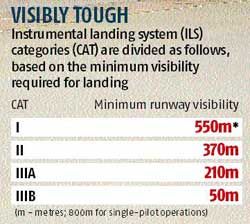 | « Back to article | Print this article |
The airline is yet to receive approval for low-visibility CAT IIIB operation from aviation regulator
 Winter fog in Delhi could play spoilsport for Vistara’s plan to launch operations early next month.
Winter fog in Delhi could play spoilsport for Vistara’s plan to launch operations early next month.
A joint venture of Tata Sons and Singapore Airlines, Vistara is ready to take off from January 9.
Bookings are already open, trial flights are being conducted.
But to complement its preparations, the airline will need a bit of luck and fair weather, too.
That’s because Vistara is yet to get an approval from the Directorate General of Civil Aviation for low-visibility CAT IIIB operations in New Delhi.
In a CAT IIIB operation, aircraft can land in visibility of as low as 50m.
While other airlines are certified for it, Vistara is certified only for CAT I operation, which allows its aircraft to land only if the visibility is 550m or more (see chart).
The minimum visibility requirement for an aircraft to take off from New Delhi is 125m.
Vistara’s daily schedule includes three flights between New Delhi and Mumbai and a flight between New Delhi and Ahmedabad, with the return leg.
Of particular concern to the airline would be the Mumbai-New Delhi morning flight which lands in the capital around 10 am. Poor visibility could lead to diversions.
Usually, visibility at New Delhi airport improves around 9-9:30 am and is above 550m. On Sunday, though, visibility was below 50m for several hours in the morning.
This meant not a single aircraft could land or take off and incoming flights were diverted to Ahmedabad or Jaipur.
“Airline executives need to use their judgement and a good idea is to delay departure in case visibility is below requirement at New Delhi,” said an aviation source.
A Vistara spokesperson said: “We are certified for CAT I landing. We have applied to the DGCA for CAT II/III operations in New Delhi.
"Most of our pilots have been trained and are qualified to operate in CAT II/III conditions and our aircraft are certified.
"We are currently working with DGCA on the approval process.”
 In order to conduct low-visibility landings an airline requires certification for its aircraft and pilots.
In order to conduct low-visibility landings an airline requires certification for its aircraft and pilots.
Pilots need to undergo ground training, simulator training and flying under the supervision of examiners.
They also need to undergo checks and supervised flying every six months in order to retain their ratings and the DGCA issues certification to an airline after it demonstrates a stipulated number of simulated low-visibility landings.
In the last few years, the New Delhi airport has had the thickest fog between December 22 and January 1, with runway visibility dropping below 50m and resulting in suspension of airport operations.
This year, too, the Met department expects the cold wave to abate and fog conditions to subside by December 31.
Last winter, the New Delhi airport experienced visibility below 50-metre for a total of 90 minutes.
Low-visibility operations under CAT IIIB conditions (visibility ranging from 50-175 m) were carried out for 56 hours between December 15 and February 15.
Vistara will be the first domestic airline to operate from Mumbai airport’s Terminal 2 (T2).
At present T2 only handles international flights.
The exception are domestic legs of Air India’s international flights (Mumbai-Delhi-New York).
Other domestic airlines are expected to move to T2 in the latter half of 2015 with the expansion of the terminal.
Image: A Singapore Airlines stewardess poses at a first class cabin seat during the launch of their new generation of cabin products at Changi Airport in Singapore. Photograph: Edgar Su/Reuters